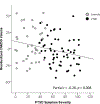Automated measurement of hippocampal subfields in PTSD: Evidence for smaller dentate gyrus volume
- PMID: 28923718
- PMCID: PMC6816338
- DOI: 10.1016/j.jpsychires.2017.09.007
Automated measurement of hippocampal subfields in PTSD: Evidence for smaller dentate gyrus volume
Abstract
Smaller hippocampal volume has been consistently observed as a biomarker of posttraumatic stress disorder (PTSD). However, less is known about individual volumes of the subfields composing the hippocampus such as the dentate gyrus and cornu ammonis (CA) fields 1-4 in PTSD. The aim of the present study was to examine the hypothesis that volume of the dentate gyrus, a region putatively involved in distinctive encoding of similar events, is smaller in individuals with PTSD versus trauma-exposed controls. Ninety-seven recent war veterans underwent structural imaging on a 3T scanner and were assessed for PTSD using the Clinician-Administered PTSD Scale. The hippocampal subfield automated segmentation program available through FreeSurfer was used to segment the CA4/dentate gyrus, CA1, CA2/3, presubiculum, and subiculum of the hippocampus. Results showed that CA4/dentate gyrus subfield volume was significantly smaller in veterans with PTSD and scaled inversely with PTSD symptom severity. These results support the view that dentate gyrus abnormalities are associated with symptoms of PTSD, although additional evidence is necessary to determine whether these abnormalities underlie fear generalization and other memory alterations in PTSD.
Keywords: FreeSurfer; Hippocampus; MRI; Memory; Stress disorders; Veterans.
Published by Elsevier Ltd.
Figures



References
-
- Blake DD, Weathers FW, Nagy LM, Kaloupek DG, Gusman FD, Charney DS, et al. The development of a Clinician-Administered PTSD Scale. J Trauma Stress 1995; 8: 75–90. - PubMed
-
- Buckner RL, Head D, Parker J, Fotenos AF, Marcus D, Morris JC, et al. A unified approach for morphometric and functional data analysis in young, old, and demented adults using automated atlas-based head size normalization: reliability and validation against manual measurement of total intracranial volume. Neuroimage 2004; 23: 724–38. - PubMed
-
- Geuze E, Vermetten E, Bremner J. MR-based in vivo hippocampal volumetrics: 1. Review of methodologies currently employed Nature Publishing Group; 2005. - PubMed
Publication types
MeSH terms
Grants and funding
LinkOut - more resources
Full Text Sources
Other Literature Sources
Medical
Miscellaneous

